The original 2014 Hoka Clifton was truly a unique product. Where lesser neutral cushioning shoes would bog you down with their softness, the ultra cushioned Clifton did quite the reverse – it could potentially better your pace, or at the very least, have zero negative impact on your speed. Which was truly remarkable, considering the level of travel or compression the chunky midsole had to offer.
In retrospect, the Clifton’s superlative feel on the road was a combination of many things meshing well together. A minimally constructed, racing flat kind of upper kept distraction levels at a minimum while keeping the foot well ventilated. This design approach allowed the Clifton to maintain a very low weight, and even for a largish US 11, the shoe weighed just 8 oz/239 grams, far below the industry threshold for this category.
That no-frills upper was glued on to a single density EVA midsole which felt resilient and cushioned without a trace of mush. The prominently rockered midsole encouraged quick transitions, which undoubtedly played a part in contributing to the fast feel.
The shoe wasn’t without its shares of flaws. There were a few areas of complaints, like a narrow forefoot or the noticeable lacing top-down pressure near the tongue top. Yet, all was forgiven once you started running in the Clifton; the sheer brilliance of the ride eclipsed these minor irritants. It also helped that the Clifton retailed at $130, significantly undercutting the rest of the exorbitantly priced Hokas.
If a shoe was to be credited with giving the strangely named footwear brand a stimulus in retail sales, it would most certainly be the Clifton. The introductory 2014 version sold to universal acclaim, and we heaped plaudits on it in our review last year.

It’s always hard to have a successful follow-on act. Especially when the shoe in question is the Clifton.

The forefoot of the Clifton 2. A lot looks familiar, take the spacer mesh and no-sew layers for example.
So here comes the tricky part, an annual ritual which most existing owners anticipate with a sense of uneasy foreboding. How does one go about updating a shoe like the Clifton, without alienating hordes of new Hoka converts?
Sometimes, the brands get this process right. They’ll keep the essence of the product undisturbed, while infusing updates which serve as incremental improvements. The second scenario is where the outcome turns out to be somewhat undesirable.
The brand will tinker with the core character of the shoe, sugar coating the changes as ‘refinements’. In other words, the new shoe strays away from what made it much liked in the first place to begin with.
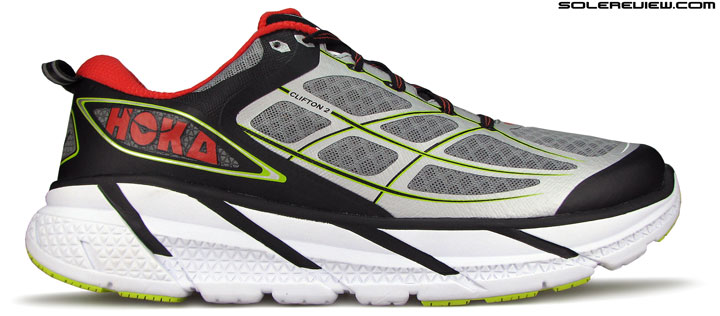
Looks quite the same as the Clifton OG, but this one’s different, and not necessarily an improvement
Unfortunately, the Hoka Clifton 2 ends up being a case study of what not to do when refreshing a popular shoe. And our point of view is based on two things, which you’re free to take with a grain of salt, as your viewpoint might differ:
1) A change in the shoe’s core personality.
2) The shoe’s ability to differentiate itself from the rest of Hoka’s oversized cushioning assortment.
And just how has the Hoka Clifton 2 changed? Let’s rattle off the quick list of update areas. The midsole has become firmer, which is at odds with Hoka’s claim of ‘keeping the industry leading ride unchanged’.
The upper gets a new padded tongue, the collar area feels different, the toe-box design goes under the proverbial scalpel, and finally, all these changes add up to substantially bump the new Clifton’s weight up by no less than a full ounce for a half-pair of US 11.
This also means that the Clifton 2’s place in the Hoka line-up has changed, and the segmentation that was once very clear is now blurred. If you’re a running shoe geek hoarding multiple pairs in your closet – and perchance the Saucony Kinvara happens to be one of them – then the latter’s evolution is an apt analogy to refer to.
The Hoka Clifton refresh is akin to the Kinvara’s update history, or more specifically, the difference in character between a Kinvara 3 and Kinvara 5. The newer Kinvaras softened up the ride, and transformed their once minimal uppers to something more built up. While many appreciated the ‘improved’ ride and the supportive upper, the core persona of the older Kinvara was lost forever.
In the same spirit of things, many will respond positively to the Clifton 2’s firmer ride and structural additions on its upper. Particularly runners who found the original Clifton too soft, and the flat tongue too thin. Ok, we’ll come to the upper in a moment, let’s park it for now. The ride quality merits a discussion of its own.
The past year, we’ve sampled different Hoka flavors, namely the Clifton, Vanquish (presumably a stand-in for the Conquest too), Bondi 4 (tested but not reviewed) and the Constant. All of these models were adequately differentiated from one another; the Clifton was the softest and lightest, while the Bondi 4 had deeper cushioning with a more built-up upper.
The supportive Constant lay somewhere between the Bondi 4 and Vanquish in cushioning softness while offering a roomy upper. The Vanquish was the firmest of the lot, and like the Bondi 4, came with a narrow toe-box. It was almost as if you could mentally place these models in different boxes, or at the very least, separated by well demarcated lines representing what each of these models stood for.
So when the Clifton 2 turns out to be a firmer Clifton with a noticeably bulkier upper, that sense of distinction gets diluted. The new version gets a design nudge which displaces the Clifton from its original place, and pushes it closer towards Bondi territory.
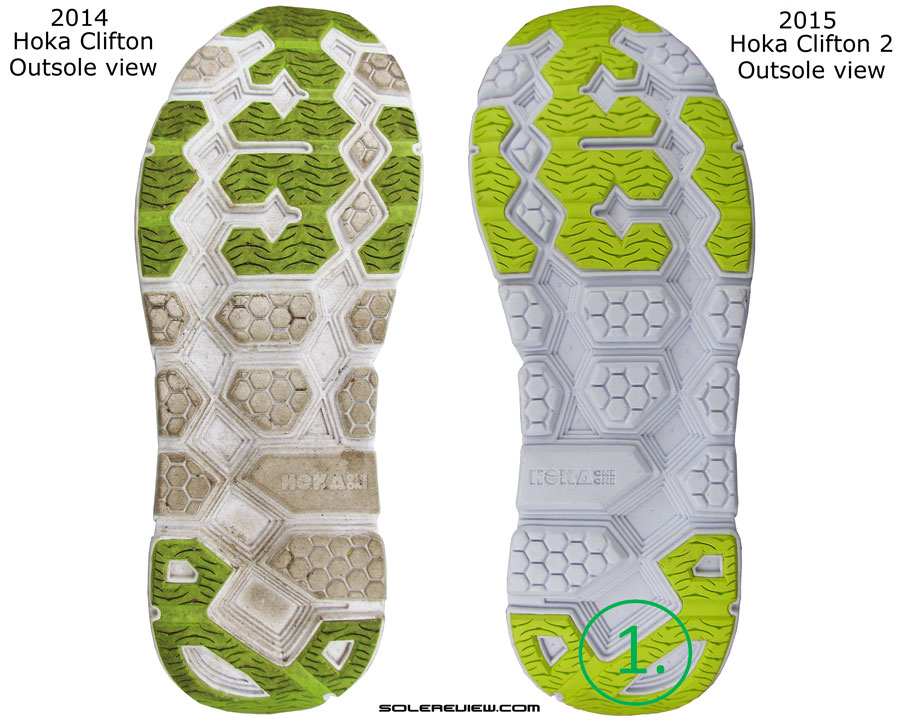
1) Our pair had a lower heel spring (angle between the midsole curve and the ground) than the Clifton 1.

This year, the Clifton uses a proper-thickness Ortholite insole instead of the pancake-flat one. But the design isn’t perfect.
As far as the actual midsole aesthetic is concerned, nothing has changed. The Clifton’s midsole design mirrors the one used on the Clifton OG, a single density slab of compression molded EVA (Ethylene Vinyl Acetate) foam with slanted grooves accentuated by black paint.
The carry-over sole design nonetheless, changes happen in three different areas, influencing the Clifton’s ride in a few ways. Firstly, the foam is firmed up, and hence the bounciness of EVA you felt on the Clifton 2 drops a couple of notches.
Next up, the drop-in footbed gets swapped on the Clifton 2, which now comes with a much thicker Ortholite insole. This update impacts the ride behavior as well, as the thicker foam insulates the feedback from the EVA midsole.

1) Forefoot still stays narrow over the small toe 2) Firmer EVA foam density 3) Lower rocker, or heel spring.
And the third update actually involves the heel spring or rocker angle. Now this could be a manufacturing anomaly, but we’re going by the experience had on our pair.
When put side-by-side, the Clifton 2’s midsole heel does not curl upwards as much as the 2014 model did. In other words, the rockered effect is toned down on the Clifton 2. Does it affect the ride? We believe it does, and we’ll explain how during the ride break-out.

The Hoka Ortholite profile is now closer to the industry standard – reasonable thickness and a well defined reverse profile.
The new Ortholite insole is much cushier than both the existing variants of Hoka sockliners – the pancake flat Ortholite seen on the Vanquish/Bondi, and the compression molded EVA version which came supplied with the original Clifton.
However, the increased footbed cushioning isn’t compensation enough for the noticeably firmer midsole, so the net outcome still remains unswayed, in the form of a firmer ride than the Clifton 1.

The Clifton 2 insole (top) is firmer than the Clifton 1 edges (below). The latter was much more pliable, softer on the foot.
But the new insole isn’t perfect. The edge thickness isn’t consistent around its circumference, with the forefoot area having a thick edge, and this progressively thins out towards the arch area. The edge which comes in contact with the forward arch is molded thinner, and hence is considerably harder (higher density) than the forefoot edge.
Also worth noting is that the Clifton midsole has a pre-existing pressure spot, but this was a non-issue on the original Clifton. Because the foam was softer, and so was the white EVA insole atop it. The Clifton 1 insole also came with its own bugs, like excess material around its edges creasing around the heel area, but it wasn’t bad enough to halt a run.
Our experience with the Clifton 2’s insole went something like this – the difference in footbed edge resulted in a small blister after a few miles. The discomfort was partially alleviated by changing the position of the insole within the shoe, moving the molded edge away from the upper.
But the sense of irritation lingered on, and ultimately the new ‘improved insole’ had to be swapped with the subtler EVA footbed of the Clifton 1. The new insole might prove to be an issue on your pair, or might not be; but this is a heads-up, just in case.
This reinforces our impression that Hoka does not pay as much attention to the finer aspects nor concerned with the pursuit of applying footwear design best practices. As a result, most of their shoes feel like examples of work-in-progress. They really need to shed this mindset, because this holds the brand back from achieving greater heights. Far better things are expected of a product line which is retailed at $130 upwards.
If they’re working behind the scenes to fix this, great. But so far the evidence of an corrective mindset eludes its finished products. We’re hopeful this will change.
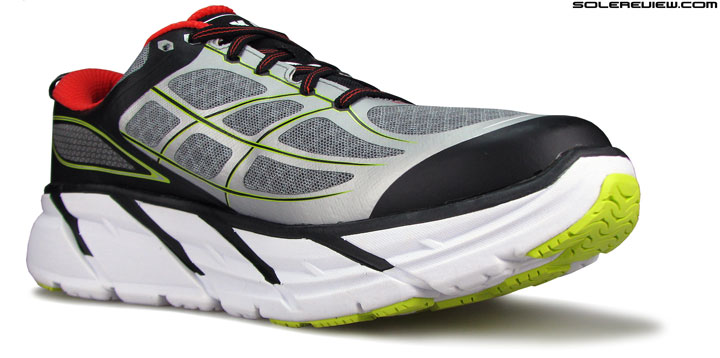
The Hoka Clifton still remains a very well cushioned and responsive shoe, regardless of the internal going-ons.

The stacked design is one of the reasons why this midsole design feels responsive; the lower base splays out on impact, acting as a damping mechanism. Sort of.
As a long distance muncher, the Clifton 2 gets the job done well. The midsole packs in mighty gobs of cushioning, and has the trademark Hoka depth of ride. The midsole is also responsive, only less bouncy than before.
Except that the Clifton 2 feels a bit slower than the C-1, which was a bit surprising since a firmer midsole usually achieves the exact opposite. And here’s why we think it is so.
The main culprit is the Clifton 2’s massive weight increase. It gains a full ounce (32 grams) over last year’s Clifton, and for something in that weight category, the degree of weight gap is huge. For a US 11, the new Clifton is now 271 grams, hugely bulked up over 239 grams of the Clifton 1. A shoe skirting on the 300 gram border will feel different than a 239 gram shoe, no matter what your personal take on a shoe is.
We also see the Clifton 2’s relative slowness to be brought upon by the difference in the heel rocker angle. As the Clifton’s 2 heel has a lower bevel, the ground contact area is marginally lengthened, and possibly impacting transition quality.
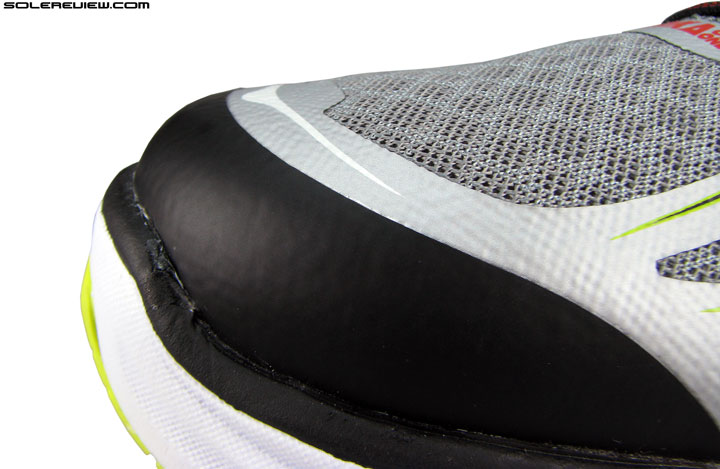
The new Clifton 2’s toe-box drops the stitched-on synthetic leather bumper, and adopts the molded design of the Bondi and Vanquish.
The new upper also comes with additional structural reinforcements, which apart from increasing weight, makes the Clifton feel like more of a shoe during runs. The toe area design moves away from the simple synthetic-leather-bumper format, and adopts what’s more common on the other Hokas.
The entire toe-box is made of this stiffer, molded material seen on shoes such as the Vanquish and Bondi 4. In the process, the toe-box becomes a bit pointier, and earlier Hoka Clifton users will miss the independence of movement afforded by the previous toe-box design.

There’s a additional last eyelet crudely punched into the printed hexagon. This was missing on the 2014 Clifton.
Come to the midfoot, and there’s a major update on the Clifton 2. The thin tongue with its scooped flap is replaced by a conventional, foam filled tongue – again, a design approach fashioned in the style of other maximal Hoka models.
The lacing style also goes from round to flat, and there’s an additional row of eyelet punched in for heel lock lacing.
Back on the heel, things firm up a little. The softer synthetic leather employed by the 2014 Clifton is substituted by a harder, no-sew overlay which ends just below the foam lining on the outside.
You have the familiar pull tab, and some newly introduced decorative texture adorns sides of the heel, and topped off by a new reflective Hoka bird logo.

1) The new insole bites the forward arch 2) Tighter midfoot top down pressure 3) Change in the heel grip quality.
And the results of all these updates? Ok, the one thing which really matters hasn’t changed, and that’s Hoka’s much talked about, narrow forefoot fit.
The upper still retains that pressure hot spot over the small/pinky toe, and moreover, the toe-box’s vertical height gets reduced when compared to the 2014 model.

Tip toe: The difference in toe-box height is plain to see across the two models. The 2015 Clifton 2 (right) has a lower ceiling owing to its molded bumper design.
The picture here shows the difference between the highest points on the toe-box across both the models. It is pretty evident what the new toe design ends up accomplishing on the Clifton 2 (right). The molded construction lowers the point where the toe box meets the forefoot mesh area, and restricts the amount of space available there.
Ok, the tongue design of the 2014 Clifton had its shortcomings. It was very thin, which meant it let a lot of the lacing pressure though. The material used was also wonky, bleeding colors on the socks and leaving behind a shape resembling a superhero logo. This proved to be more of an issue if there was sweat involved.
Hoka threw that design out, and brought in the padded tongue this year, with the obvious intent of reducing lacing pressure. So things should be all good now, correct?
Wrong. A solution only works if it is one, and the new component swap presents problems unique to the Clifton 2. The new tongue is a much bulkier, multi-layered component with one significant change. Instead of the soft, scooped flap of the Clifton 1 tongue, the revised tongue fills that portion with a stiffer composite of synthetic Nubuck and mesh.
The firmer flap feels more intrusive, as it bears down on the skin with greater intensity than before. It does not however, result in any kind of irritation as did the Vanquish . In addition, a few more changes in upper fit come with the package.

A thicker tongue also means wider lacing, which results in top-down lacing pressure. Add tongue slide to that too.
With the thick tongue, the lacing area broadens up . Plainly explained, there’s a wider gap between either sides of the lacing, and this typically increases lacing pressure as opposed to a narrower lacing structure. And that does happen. You feel the tongue as a separate component from the rest of the upper, relative to the more cohesive nature of the Clifton 2 upper.
A wider lacing gap also encourages tongue slide, something which wasn’t felt on the 2014 Clifton – simply because the opposing midfoot panels almost touched one another. The padded tongue design also impacts midfoot grip on the sides. With the tongue being significantly thicker than the thin midfoot side panels, there’s a gap where the tongue underlays the upper sides.
This causes an interruption in the flow of the internal midfoot fit. While the upper still grips well, it misses the seamless feel of the Clifton 1. Not to mention that the new Clifton now actually needs an upper break-in period compared to the broken in feel of the 2014 Clifton. And we haven’t even started on the heel design.

…like a firmer synthetic joined with the mesh by means of a reverse seam. This makes the top part less easier to flex.
By replacing the pliable synthetic of the original Clifton with a fancy stitch less overlay, the collar edges get much firmer, necessitating the shoe to be broken in.
The Achilles drip also feels different, a consequence of a) increased foam padding, and b) the soft synthetic is replaced by the new harder material.
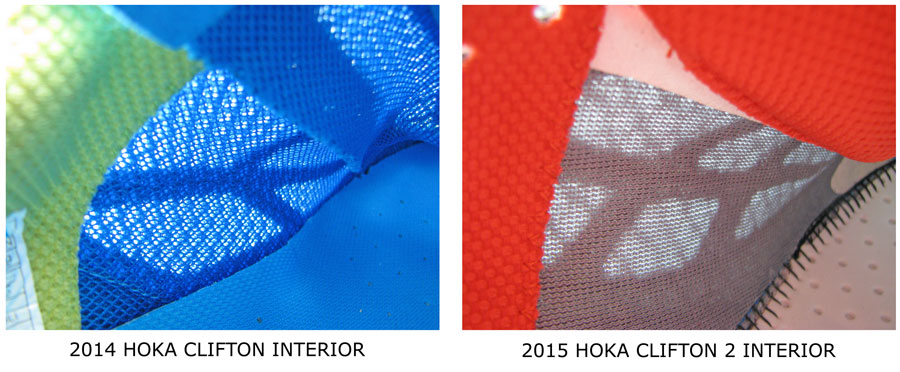
The new Hoka is a bit stuffy inside. The padded tongue blocks ventilation, and the mesh has a denser structure than before. Smaller side windows too, as you can see.
In short, the new Clifton 2 upper feels like more of a shoe during runs, moving away from the less-of-a-shoe feel which the Clifton 1 had. All Hoka had to do was to only pad the top of the tongue, referring to the Kinvara 4, adios 2 Boost and Zoom Streak 5’s tongue design. The added layering also decreases ventilation, and the new Clifton feels warmer to run in than its predecessor. A comparative picture (above) of the interior helps understand this better.
Small things matter, especially on the Clifton which is meant to go the long haul. You want an upper quick to break-in, and deliver a distraction free experience during the course of your run. Weight is a key element to achieving a sense of fast over distance, and so physical bulk has to be kept under control.
So if we had to choose sides, we’d hop over to the 2014 Clifton 1 territory, never mind its idiosyncratic quirks like a thin and color transferring tongue. And we have a feeling that a lot of existing Clifton (2014) owners would take the same call, provided everyone is aware of the changes afoot.
The 2015 Clifton 2 is very cushioned, responsive and for the most part, still a lot of fun on the road. And if your first Clifton happens to be the latest 2015 model, chances are that you’ll find much to like.
But that’s not the point, is it?
(Disclaimer: For this review, Solereview bought the shoe at full US retail price.)
Looking to upgrade your older Hoka Clifton to the latest version, but not sure how the 2015 model compares? We can help here. The following infographic is a ready-reckoner for what changes you might expect in the new model vs. old. To make this more fun, we’ve put in a system of percentage match, which calculates a weighted average for a set of attributes.
A higher or lower match percentage is neither good or bad. The % number just tells you how similar or distanced the new shoe is from the previous version. Total match % is a result of weighted averages.

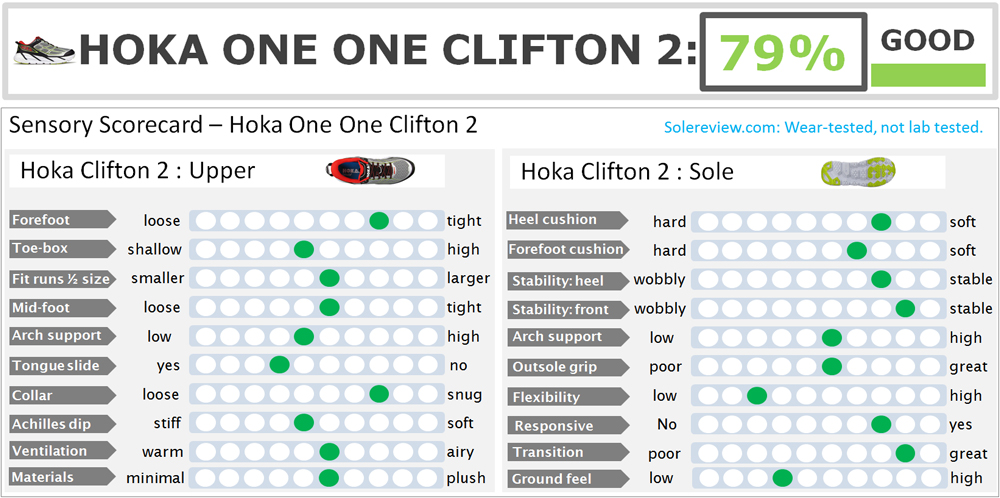
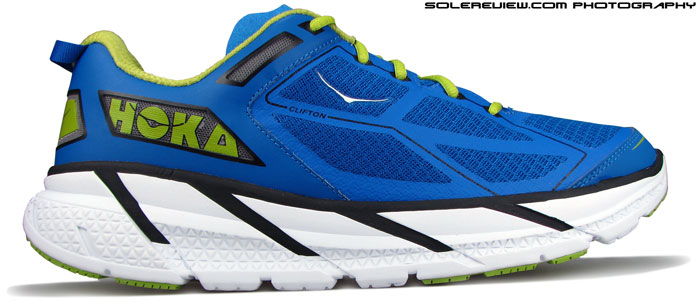
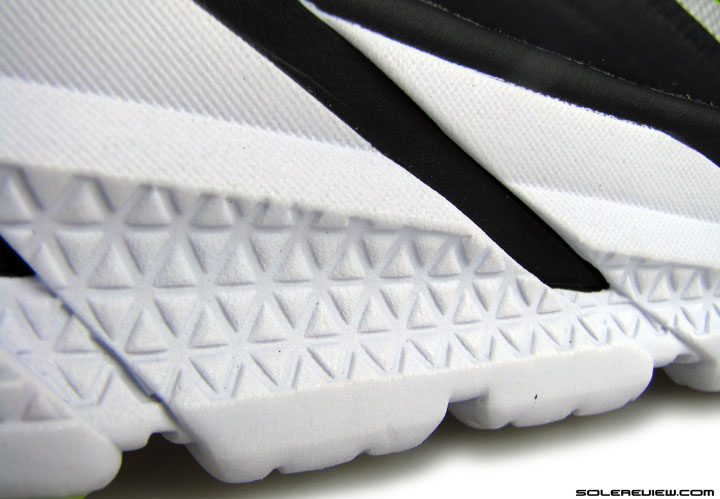

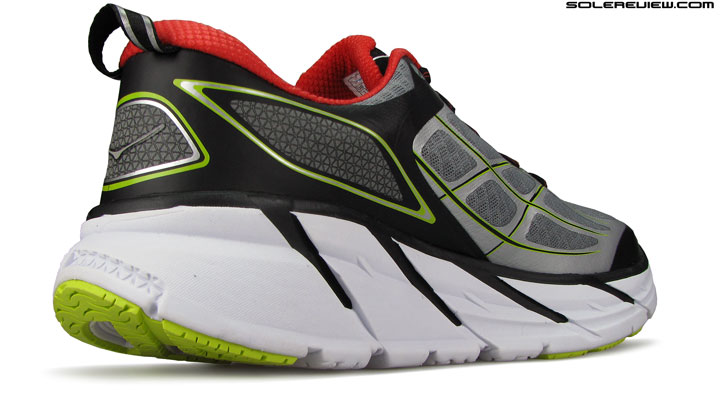
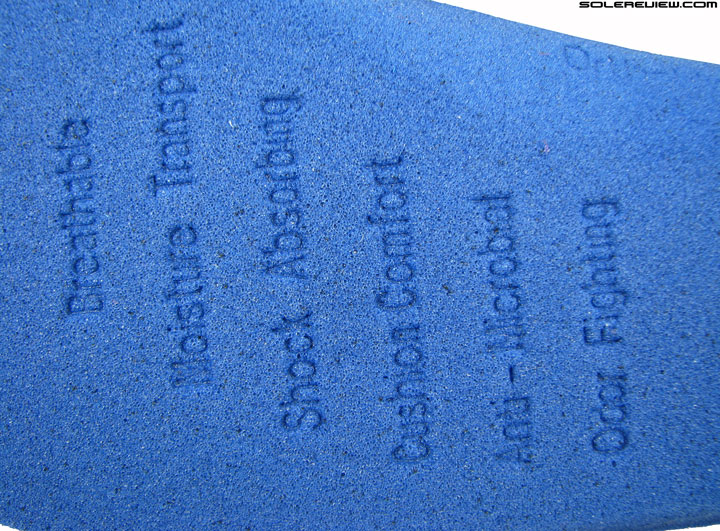
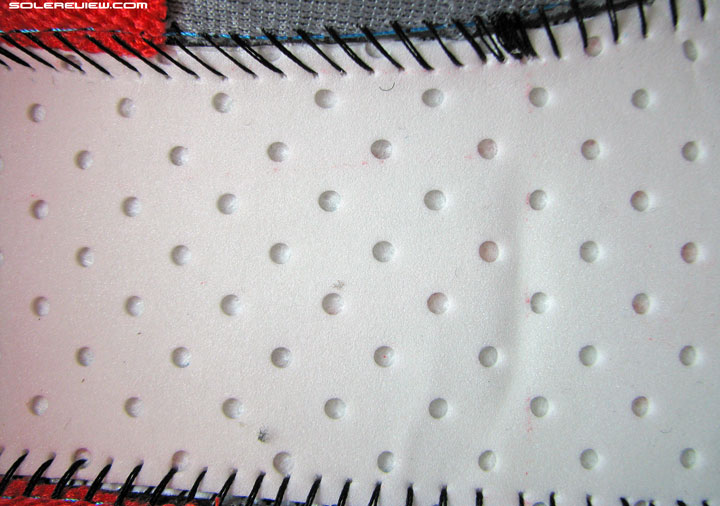
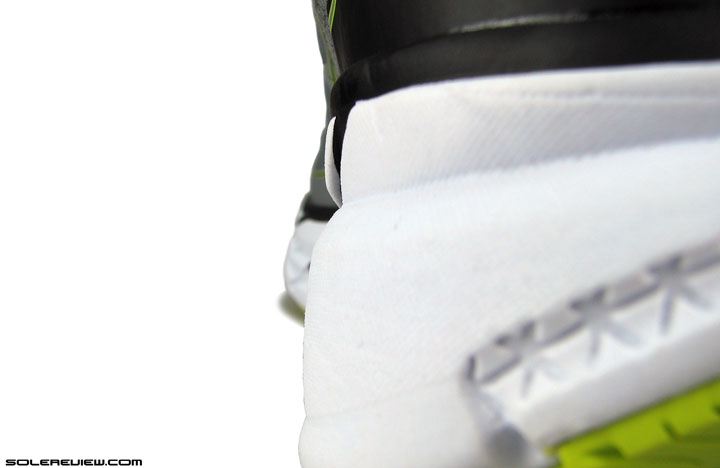


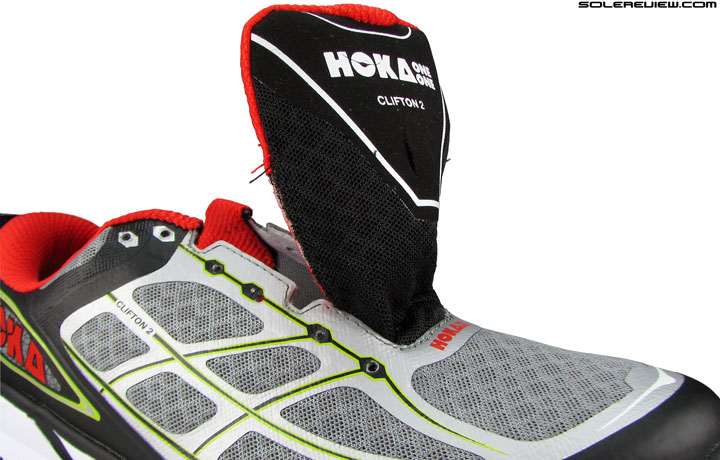
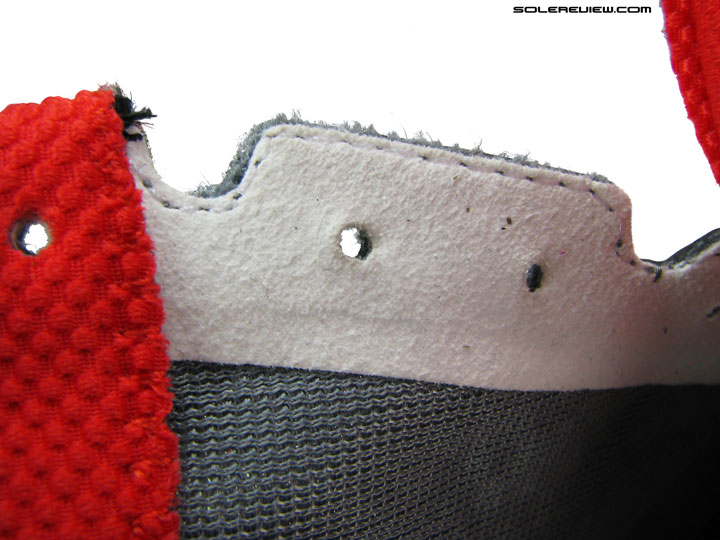






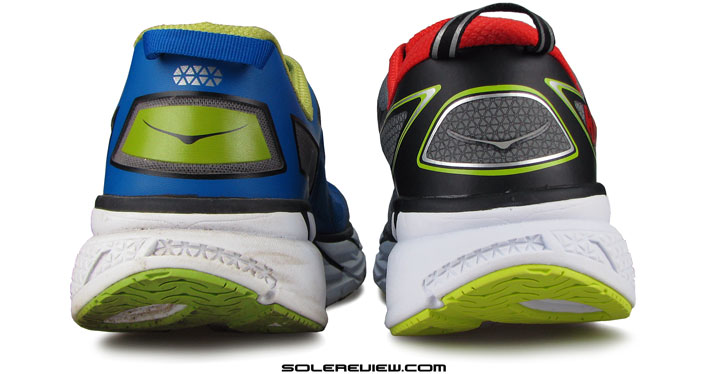


40 comments
I really like the Clifton 1 apart from the pinky toe pressure. I’m grateful that I also got the original Conquest instead of the Clifton 2 (thanks Solereview for advising the C2 was not worth the price difference). The Conquest is a little firmer than the C1, but is a nicer fit and is a bit more responsive.
Thank you for the feedback!
So I should buy the cheaper Hoka Clifton 1 instead of the Clifton 2?
Hi,
Try the Clifton 1s if you are still lucky and able to get them in your size. Otherwise you can give the 2s a try.
Cheers
Patrick
We’d buy the Clifton 1 instead.
Hi,
One thing I noticed is that the outsole rocker of the Clifton 2s is flatter than the one of my Clifton 1s. Put them on the ground and then let them bob back and forth like a rocking chair. The Clifton 2s are noticeably flatter and you can also actually see it in your photo of both shoes next to each other from the side (the white bits without rubber). Alright, the effect may be a bit more pronounced because I went up a size (US13 instead of US12.5) for the Clifton 2s.
I haven’t tried any running in them because I am only abusing them as sneakers (in black – they look considerably better than Hokas usually do ;-)).
As far as the tongue is concerned, I also feel it is a bit too short and the tip of the the tongue is too hard (apart from the soft bit in the middle). (With the Bondi 4s I found that if you wear them bearefoot you can risk blisters near the foot joint because of the tendency of the tongue to wander and the hard bits of the tip of the tongue (the inner edges of the two outside thirds to be exact) scrubbing along the foot – the soft bit is fine though – in the end I got round the problem by using all four top eyelets but in tongue pressure reduction mode, i.e. in through the outside of the front eyelet and and out through the back of the rear eyelet – that way tongue pressure was reduced sufficiently and they suddenly became immensely comfy – and proved to be very reliable holiday companions :-)).
If you tie them loosely enough, the Clifton 2s are o.k., at least for me. Tongue pressure becomes o.k. – also no more digging into the foot and in between bones etc.. However, I also prefer last year’s edition. (I’d love to have Clifton 1s in black ;-).)
I upsized them because of reports that the front bit was narrower horizontally and vertically. With the Clifton 1s my feet have bags of space in the front section and with the Clifton 2s it feels similar. My feet like a bit of room and upsizing for the Clifton 2s probably was a good idea.
Cheers
Patrick
P.S.: One good thing though. Hoka managed to do without these bloody metal eyelet supports. Someone should have a word with their design team and have them write ‘I will not use metal eyelet supports’ a 100 times (and if they are not finished by dawn cf. Life of Brian ;-)).
It is the only thing that drives me potty about my Stinson Lites – particularly in view of the combination with a wafer-thin tongue. Anyway, thanks to them I am able to 10km without any pain in my hips or knees afterwards.
Appreciate the feedback, always fun to read your detailed Hoka posts. Agree with pretty much everything you’ve said.
Hi,
More than happy to oblige :-). I also was not too happy about the insoles. I really would have preferred a pair of flat ones (with a wider mid inside section – see previous posts) as an alternative. I did play around with others (flat ones) but in the end went back to those that came with them. After all, a different height of outsole does also change the geometry of the shoes up to a point.
I have said it before but outsoles is something Hoka still has to learn despite their otherwise really good shoes.
I also thought that the heel section felt strange at the beginning but that appears to have settled. Maybe they do take a bit more time breaking in. Now they are quite comfy and sometimes I even forget which shoes I am wearing. I rather prefer that to constant painful reminders ;-).
One of these days I might even take them for a run. Until then I will stick to the Stinson Lites. They also have their quirks but the cushioning under the heel section is utterly lovely (in the Bondi 4s and Valors that probably is the game breaker for me – cushioning good but impact still too strong). I like the fact that I can kind of literally let my self drop into them while running instead of having to worry about impact and that if I were to run a km or two(ish) too many my hips (and possibly knees) would keep reminding me that this had not been a good idea at all for the rest of the week or longer.
You might like to have a look at the Stinson 3s (or even a leftover pair of the Stinson Lites) ;-).
Cheers
Patrick
Thank you for the feedback! And we’ll see what we can do about reviewing a Stinson.
Thank you for your incredible reviews :-).
silly me – I meant of course that insoles is something Hoka still has to learn ;-)
regarding the Bondi 4s and Valors I particularly meant the shape of the cushioning stuff under the heel section – for my motion apparatus it thins down too quickly – I need full height under the end of the heel section as well – that is why the Stinson Lites are so lovely for me
however particularly the Bondi 4s are lovely for long walks – partly because (!) of the shape of the cushioning stuff under the heel section – that is what I call irony ;-)
Question for both Patrick and solereview: Are the original Cliftons that you are doing the rocker comparison with used or new? I find that my running shoes of any kind become much more rockered with wear. If you are comparing a new original with the 2 or comparing photos of the original with the 2, that would be the basis for a real comparison.
Hello Andrew,
the comparison is between a new Clifton 2 and older Clifton 1. But these reviews are based on short term ownership, which means that we just have 60 miles on Clifton, and 35 on the Clifton 2. A 25 mile difference is negligible and unlikely to impact the rocker angle.
I disagree that a 25 mile difference is negligible when a shoe is relatively new and having the greatest foam breakdown rate per mile. I bought 3 pairs of Huakas last week (due to a great sale), so I just compared a Huaka with 40 miles vs. a Huaka with 0 miles. Toe to toe, the used Huaka is already 4 mm higher in front. Heel to heel, the used Huaka is 1 mm higher. Note that I’m a midfoot to forefoot striker, so that could explain the relatively minimal heel difference. The EVA material on the Clifton is also more likely to show early foam breakdown than the RMAT material on the Huaka.
It doesn’t make sense that they would change the expensive mold and not change the look at all. I can see using a slightly different foam firmness or not having tight quality control on that aspect, if, by chance, they didn’t mean to change that, but the changing mold seems like a bigger deal.
Guess we have to disagree on this one, and leave it at that.
But your comment on the mold was helpful – because after checking both versions of the Clifton, we are 100% certain that Hoka used a different midsole mold on the Clilfton 2, at least on our reviewed pair.
They look identical, but the depth of some channels is off in some places, and then the compression molding ‘nipples’ are in entirely different positions.
It is an common practice in the industry to change new molds even on the same design, for two reasons. A) to ramp up capacity and B) to replace ageing molds on a high volume model. In Clifton’s case, A) seems more likely, because Hoka would have sold relative truckloads of this model.
The way we see it, this new mold has a marginal difference in spring. Don’t think it is a quality control issue, because unlike injection molded EVA, compression molded parts hold their tolerances extremely well after pressing.
Unless their pressing pads (for sole-upper adhesion) are brand new, and slightly lower than the older one for some reason. That would explain the anomaly, then.
Hi Andrew,
Sorry for the late reply. My Clifton 1s are about a year old and fairly badly worn. However, unless my memory is playing tricks on me even when they were new they felt more rockered. Either the difference I noted was because of the different size 12.5 US for the Clifton 1s and 13 US for the Clifton 2s or something has indeed been changed regarding rocker proportions.
The latter felt a bit more like my Stinson Lites, which have an a bit more ‘conservative’ – if you want to call it that – shape. When you stand in them, the bit of the outsole in the middle between the forward and rear rocker is much flatter – i.e. it takes a bit of an effort to rock them back and forth. That is why I was so surprised about the Clifton 2s feeling so flat by comparison in the mid section of the outsole. I remember the Clifton 1s feeling rounder. For that reason I would be grateful if anyone with a new or at least newish Clifton 1s pair could be so kind as to check whether my impression was true or a load of bollocks.
Cheers
Patrick
You guys are absolutely the best in reviewing running shoes! I’m not a “Hoka” guy but appreciate the review, nonetheless. Fantastic!
Appreciate the kind words!
How do you measure cushioning? Do you use some sort of tools or this is just a subjective opinion after running in a pair of shoes? According to Hoka, there were no changes to the sole of Clifton 2. This implies that they should be as cushioned as Clifton 1.
Wear-test experience, and hand-feel. We disagree with Hoka’s claim that the shoe’s ride is unchanged.
According to Runnersworld, which uses impact tester (http://www.runnersworld.com/running-shoes/how-we-test-shoes) the cushioning of Clifton 2 (http://www.runnersworld.com/shoe/hoka-one-one-clifton-2-mens) is the same as Clifton 1 (http://www.runnersworld.com/shoe/hoka-one-one-clifton-mens#rw-review)
I did not run in Clifton 1, but rather moved from Ascis Kayano 20/21/22 to Clifton 2. The shoe has a narrow fit (similar to Kayano 21 and 22), so I had to buy half size bigger. I had hot sports under the ball of foot during initial run on treadmill. Also the forefoot cushioning (I land on forefoot/midfoot) seemed a bit firmer than I expected. But after that initial break in, it became a great shoe with fantastic cushioning (soft and responsive) somewhat similar to Adidas boost material.
Unfortunately none of Adidas shoes have enough boost material in forefoot to get the same type of padding as in Hokas.
I agree with the rest of the review (regarding padded and stiff tongue, etc). Luckily for me, none of them were an issue: love my Clifton 2.
Thanks for the links. Not sure what are the exact parameters RW’s loading mechanism are accounted for, but we’ve considered using Shore 00 and Asker C durometer gauges for measuring foam density ( a strong correlation to cushioning feel), but in the real world, these tools are not fool proof.
Sometimes it ends up being a zero sum game – density change can be compensated by updates in other components like the insole, outsole or simply how the foot rests over the foot-bed. The best way is to wear-test successive versions over a dozen runs and coax out the minute differences in character.
Appreciate the feedback on the Clifton!
Hi,
Just a little update. My Clifton 2s are beginning to feel a little softer (unless I am only imagining it). As you probably know, Hokas are supposed to become softer over time whereas other EVA shoes (I only have experience with Adidas, Asics, and New Balance) tend to get harder over time – particularly my various Adidas pairs would do so.
Maybe it is a little bit unfair to compare brand new Clifton 2s to already seasoned Clifton 1s.
Cheers
Patrick
You have a point, but we’ll stand by what we said in the review.
I purchased the Clifton 2, but will have to take them back because they are too narrow for my foot.
Is there any alternative shoe in the same segment – lots of cushioning, lowish weight, low drop – that you can recommend? I would love to try this kind of shoe during my marathon training.
The Hoka Bondi 4 in a EE width should be the perfect substitute.
I’ll check if the Bondis are available in EE in Europe. I kind of doubt it since the Hoka european web site doesn’t mention different widths. Do you think the feel is different than the Cliftons as described by clive above?
Are there any other alternatives than Hoka? Have you tried the Altra Paradigm? They look like an alternative on paper, even though the zero drop may take a bit longer to get used to.
The Bondi is a more cushioned shoe – much deeper than the Clifton. Have no idea on the Paradigm.
I bought Clifton 2 half size larger than my usual 10.5 size and they fit great. Though there is extra room length wise, but because of narrow fit, there is no slippage. Because of lower stack high, Clifton feels more like regular/normal running shoes. And they are very bouncy.
Bondi 4 is a completely different shoe because of height stack and type of cushioning: there is a lot of “give”, but no bounce-back. The fit is wider and size 10.5 fits me well.
Thanks for the info on the Bondi. A larger Clifton would feel a bit clumsy on the foot I think even if there is no slippage.
I love my old Cliftons and tried to find the same shoes. I ordered what I thought were the old version but got the newer Clifton 2. What a huge difference! They were much more narrow and the feel was totally different. Shame on Hoka for trying to foist off a very different shoe as ‘the same’. NOPE.
The Clifton 2s are going back and I ordered an old pair (hope that’s what I get).
Hello New Balance; I don’t like being lied to.
Yup, fit and ride – both have changed on the Clifton 2. They even used a different mold to make their C-2 midsoles. Figures.
Having run some 700 km on the Clifton 1 and some +300 km on the Clifton 2, I mostly agree with your views on the differences between the two. The cushioning on the C2 does seem a bit firmer than on the C1 and the metarocker is way more pronounced on the C1. I do like the snugger feel on the upper that the C2 provide despite having some issues initially with some toes rubbing against each other (nothing that vaseline and a nail file couldn’t solve) and I also think the material is a bit too stiff…The tongue on the C1 was a nightmare regarding color bleeding…my socks got blue everytime I used them (no discomfort though!), so the new tongue is better in that sense. Regarding the weight, I know the C2 is a bit heavier but as I always ran the C1 with ortholite insoles (that piece of paper that looks like an insole that came originally with the shoe was garbage), the difference is only about 30 grams. All in all, there are some things that I like on the C2 and despite my initial impression of “wow, these are better than the C1”, having put some more runs in them I am beginning to think that If I could go back, I would probably have bought another pair of C1 instead of the C2! For me, the perfect shoe would be a Saucony with the cushioning of the Clifton 1! Anything else on the market with similar cushioning and that doesn’t weigh a tonne?
Thank you for the very detailed feedback. Happy to hear that our short-term impression matches up with your long-term ownership report!
Based on the shoes we’ve reviewed, nothing comes close to a Clifton except another Hoka. Like the Bondi 4.
The comments/Q&A thread will be closed till January 17, 2016. Any inconvenience is regretted. Premium members can continue to use their comments section, which will be open.
Appreciate your detailed post. I loved the original cliftons but did not like the Clifton 2. I am almost ready for new shoes and can’t find the original model anywhere. Any suggestions? A different hoka model? Will the Clifton 3s be better?
Not sure of the Clifton 3, but they should be around in a couple of months. We do wonder though how the Odyssey rides – they have a very Clifton-ey kind of sole.
Comments are closed.